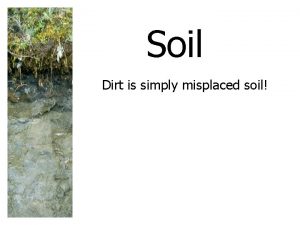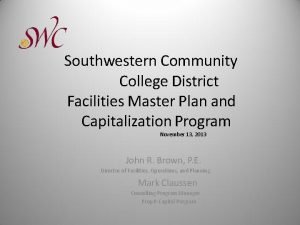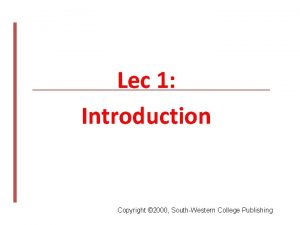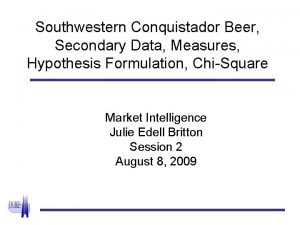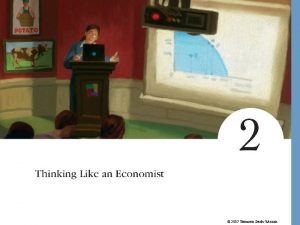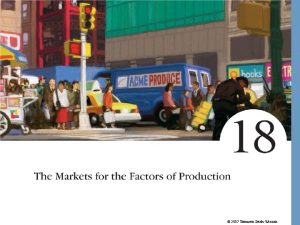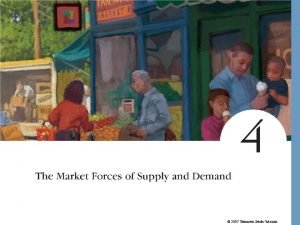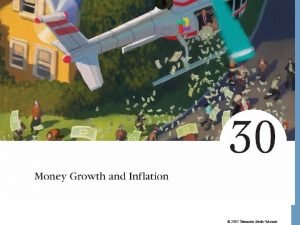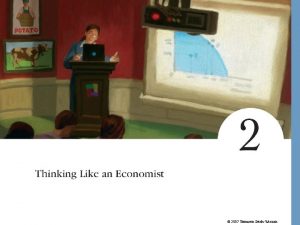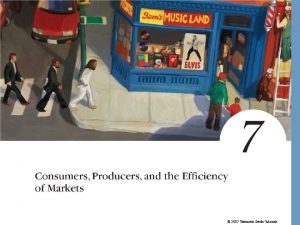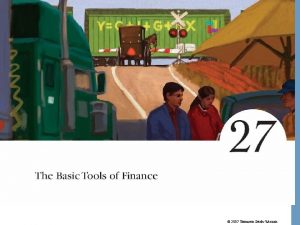2007 Thomson SouthWestern The Markets for the Factors








































- Slides: 40

© 2007 Thomson South-Western

The Markets for the Factors of Production • Factors of production are the inputs used to produce goods and services. • The demand for a factor of production is a derived demand. • A firm’s demand for a factor of production is derived from its decision to supply a good in another market. © 2007 Thomson South-Western

THE DEMAND FOR LABOR • Labor markets, like other markets in the economy, are governed by the forces of supply and demand. © 2007 Thomson South-Western

Figure 1 The Versatility of Supply and Demand (a) The Market for Apples (b) The Market for Apple Pickers Price of Apples Supply P Wage of Apple Pickers Supply W Demand 0 Q Quantity of Apples 0 L Quantity of Apple Pickers The apple producer’s demand for apple pickers is derived from the market demand for apples. © 2007 Thomson South-Western Copyright© 2003 Southwestern/Thomson Learning

The Competitive Profit-Maximizing Firm • Most labor services, rather than being final goods ready to be enjoyed by consumers, are inputs into the production of other goods. © 2007 Thomson South-Western

The Production Function and the Marginal Product of Labor • The production function illustrates the relationship between the quantity of inputs used and the quantity of output of a good. © 2007 Thomson South-Western

Table 1 How the Competitive Firm Decides How Much Labor to Hire © 2007 Thomson South-Western

The Production Function and the Marginal Product of Labor • The marginal product of labor is the increase in the amount of output from an additional unit of labor. • MPL = Q/ L • MPL = (Q 2 – Q 1)/(L 2 – L 1) © 2007 Thomson South-Western

The Production Function and the Marginal Product of Labor • Diminishing Marginal Product of Labor • As the number of workers increases, the marginal product of labor declines. • As more and more workers are hired, each additional worker contributes less to production than the prior one. • The production function becomes flatter as the number of workers rises. • This property is called diminishing marginal product. © 2007 Thomson South-Western

The Production Function and the Marginal Product of Labor • Diminishing marginal product refers to the property whereby the marginal product of an input declines as the quantity of the input increases. © 2007 Thomson South-Western

Figure 2 The Production Function Quantity of Apples Production function 300 280 240 180 100 0 1 2 3 4 5 Quantity of Apple Pickers © 2007 Thomson South-Western

The Value of the Marginal Product and the Demand for Labor • The value of the marginal product is the marginal product of the input multiplied by the market price of the output. • VMPL = MPL P © 2007 Thomson South-Western

The Value of the Marginal Product and the Demand for Labor • The value of the marginal product (also known as marginal revenue product) is measured in dollars. • It diminishes as the number of workers rises because the market price of the good is constant. © 2007 Thomson South-Western

The Value of the Marginal Product and the Demand for Labor • To maximize profit, the competitive, profitmaximizing firm hires workers up to the point where the value of the marginal product of labor equals the wage. • VMPL = Wage • The value-of-marginal-product curve is the labor demand curve for a competitive, profitmaximizing firm. © 2007 Thomson South-Western

Figure 3 The Value of the Marginal Product of Labor Value of the Marginal Product Market wage Value of marginal product (demand curve for labor) 0 Profit-maximizing quantity Quantity of Apple Pickers © 2007 Thomson South-Western

FYI—Input Demand Output Supply: Two Sides of the Same Coin • When a competitive firm hires labor up to the point at which the value of the marginal product equals the wage, it also produces up to the point at which the price equals the marginal cost. © 2007 Thomson South-Western

What Causes the Labor-Demand Curve to Shift? • The Output Price – VMPL is MPL x Price of Output. So if P^ VMPL^ so Demand for VMPL^ • Technological Change – Could have a positive or negative relationship with labour demand • The Supply of Other factors – a reduction in supply of equipment could lower MPL hence lower demand © 2007 Thomson South-Western

THE SUPPLY OF LABOR - thurs • The Trade-off between Work and Leisure – The labor supply curve reflects how workers’ decisions about the labor-leisure trade-off respond to changes in opportunity cost. – An upward-sloping labor supply curve means that an increase in the wages induces workers to increase the quantity of labor they supply. © 2007 Thomson South-Western

What Causes the Labor Supply Curve to Shift? • Changes in Tastes –Women in the workforce, demand for nicer things, shift in retirement age • Changes in Alternative Opportunities – other employment options change • Immigration – causes an increase in labour • Disease and death • Famine © 2007 Thomson South-Western

An example of opportunity cost? • Why do surgeons and doctors work such long hours? • A brain surgeon has a higher opportunity cost of enjoying leisure than a janitor because the surgeon’s wage is so much higher. That is why doctors work such long hours because leisure is very expensive for them. © 2007 Thomson South-Western

EQUILIBRIUM IN THE LABOR MARKET • The wage adjusts to balance the supply and demand for labor. • The wage equals the value of the marginal product of labor. © 2007 Thomson South-Western

Figure 4 Equilibrium in a Labor Market Wage (price of labor) Supply Equilibrium wage, W Demand 0 Equilibrium employment, L Quantity of Labor © 2007 Thomson South-Western

Shifts in Labor Supply • Labor supply and labor demand determine the equilibrium wage. • Shifts in the supply or demand curve for labor cause the equilibrium wage to change. © 2007 Thomson South-Western

Figure 5 A Shift in Labor Supply Wage (price of labor) 1. An increase in labor supply. . . Supply, S S W W 2. . reduces the wage. . . Demand 0 L Quantity of Labor 3. . and raises employment. L © 2007 Thomson South-Western

Shifts in Labor Supply • An increase in the supply of labor: • • • Results in a surplus of labor. Puts downward pressure on wages. Makes it profitable for firms to hire more workers. Results in diminishing marginal product. Lowers the value of the marginal product. Gives a new equilibrium. © 2007 Thomson South-Western

Shifts in Labor Demand • An increase in the demand for labor : • • Makes it profitable for firms to hire more workers. Puts upward pressure on wages. Raises the value of the marginal product. Gives a new equilibrium. © 2007 Thomson South-Western

Figure 6 A Shift in Labor Demand Wage (price of labor) Supply W 1. An increase in labor demand. . . W 2. . increases the wage. . . D Demand, D 0 L Quantity of Labor 3. . and increases employment. L © 2007 Thomson South-Western

Table 2 Productivity and Wage Growth in the United States © 2007 Thomson South-Western

THE OTHER FACTORS OF PRODUCTION: LAND CAPITAL • Capital refers to the equipment and structures used to produce goods and services. – The economy’s capital represents the accumulation of goods produced in the past that are being used in the present to produce new goods and services. © 2007 Thomson South-Western

OTHER FACTORS OF PRODUCTION: LAND CAPITAL • Prices of Land Capital – The purchase price is what a person pays to own a factor of production indefinitely. – The rental price is what a person pays to use a factor of production for a limited period of time. © 2007 Thomson South-Western

Equilibrium in the Markets for Land Capital • The rental price of land the rental price of capital are determined by supply and demand. • The firm increases the quantity hired until the value of the factor’s marginal product equals the factor’s price. © 2007 Thomson South-Western

Figure 7 The Markets for Land Capital (a) The Market for Land Rental Price of Land (b) The Market for Capital Rental Price of Capital Supply P Demand 0 Q Quantity of Land 0 Q Quantity of Capital © 2007 Thomson South-Western

Equilibrium in the Markets for Land Capital • Each factor’s rental price must equal the value of its marginal product. • They each earn the value of their marginal contribution to the production process. © 2007 Thomson South-Western

Linkages among the Factors of Production • Factors of production are used together. • The marginal product of any one factor depends on the quantities of all factors that are available. © 2007 Thomson South-Western

Linkages among the Factors of Production • A change in the supply of one factor alters the earnings of all the factors. • A change in earnings of any factor can be found by analyzing the impact of the event on the value of the marginal product of that factor. © 2007 Thomson South-Western

Summary • The economy’s income is distributed in the markets for the factors of production. • The three most important factors of production are labor, land, and capital. • The demand for a factor, such as labor, is a derived demand that comes from firms that use the factors to produce goods and services. © 2007 Thomson South-Western

Summary • Competitive, profit-maximizing firms hire each factor up to the point at which the value of the marginal product of the factor equals its price. • The supply of labor arises from individuals’ trade-off between work and leisure. • An upward-sloping labor supply curve means that people respond to an increase in the wage by enjoying less leisure and working more hours. © 2007 Thomson South-Western

Summary • The price paid to each factor adjusts to balance the supply and demand for that factor. • Because factor demand reflects the value of the marginal product of that factor, in equilibrium each factor is compensated according to its marginal contribution to the production of goods and services. © 2007 Thomson South-Western

Summary • Because factors of production are used together, the marginal product of any one factor depends on the quantities of all factors that are available. • As a result, a change in the supply of one factor alters the equilibrium earnings of all the factors. © 2007 Thomson South-Western

Summary • • Homework Pg 408 -410 Q#1, 2, 3, 4, 5 Pr. # 1, 3, 5, 7, 8, 10 © 2007 Thomson South-Western
 Thomson southwestern
Thomson southwestern 2007 thomson higher education
2007 thomson higher education Simply misplaced
Simply misplaced Chapter 18 the markets for the factors of production
Chapter 18 the markets for the factors of production Southwestern college publishing
Southwestern college publishing Southwestern college publishing
Southwestern college publishing Kappa alpha psi southwestern province
Kappa alpha psi southwestern province Kappa alpha psi southwestern province
Kappa alpha psi southwestern province Southwestern community college
Southwestern community college Rutgers law symplicity
Rutgers law symplicity Southwestern college cincinnati ohio
Southwestern college cincinnati ohio Kappa alpha psi southwestern province
Kappa alpha psi southwestern province South-western college publishing
South-western college publishing Ophthalmology
Ophthalmology Southwestern conquistador beer case solution
Southwestern conquistador beer case solution Century 21 southwestern accounting
Century 21 southwestern accounting Southwest province kappa psi
Southwest province kappa psi Catherine carpenter southwestern
Catherine carpenter southwestern Kappa psi southwest province
Kappa psi southwest province Southwestern province
Southwestern province Enheter för massa
Enheter för massa Fuktmätningar i betong enlig rbk
Fuktmätningar i betong enlig rbk Kraft per area
Kraft per area Elektronik för barn
Elektronik för barn Personalliggare bygg undantag
Personalliggare bygg undantag Tack för att ni har lyssnat
Tack för att ni har lyssnat Borra hål för knoppar
Borra hål för knoppar Bris för vuxna
Bris för vuxna Smärtskolan kunskap för livet
Smärtskolan kunskap för livet Trög för kemist
Trög för kemist Jiddisch
Jiddisch Autokratiskt ledarskap
Autokratiskt ledarskap Humanitr
Humanitr Vad står k.r.å.k.a.n för
Vad står k.r.å.k.a.n för Toppslätskivling effekt
Toppslätskivling effekt Redogör för vad psykologi är
Redogör för vad psykologi är Mat för idrottare
Mat för idrottare Gumman cirkel
Gumman cirkel Bästa kameran för astrofoto
Bästa kameran för astrofoto Etik och ledarskap etisk kod för chefer
Etik och ledarskap etisk kod för chefer Svenskt ramverk för digital samverkan
Svenskt ramverk för digital samverkan


